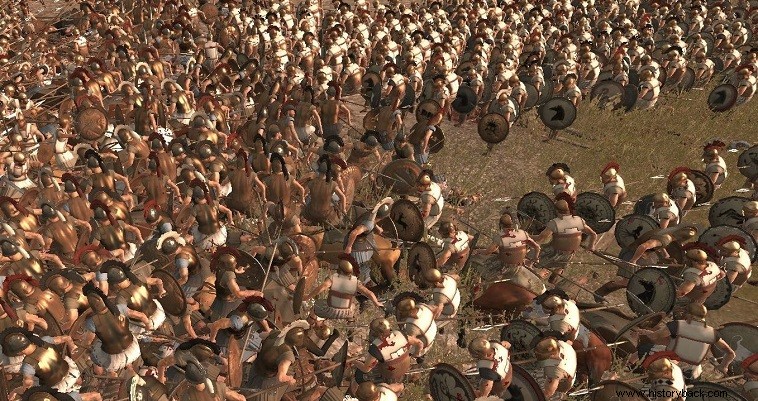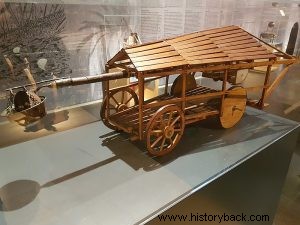
The battle of Delion took place in 424 BC. during the Peloponnesian War between the Athenians and the Spartan allies the Boeotians. The battle was followed by the siege of Delion and the use of the famous flamethrower of the Boeotians.
The Athenians had planned to campaign in Boeotia in support of the "democratic" allies with two corps, one under general Demosthenes and one under the general Hippocrates . However, the generals failed to coordinate their movements.
At the same time, the Athenian plan was betrayed to the Poles and thus Hippocrates found himself alone in Boeotia. In Delio, which is identified with today's Delesi, the Athenians remained five days fortifying the city. After leaving an Athenian garrison, Hippocrates decided to retreat.
The Boeotians, under Pagonda they had already, in the meantime, gathered their forces and marched against the Athenians. The Boeotians approached the area where the Athenian-allied army of 15,000 men of Hippocrates was stationed.
Opposing forces
Pagondas had at his disposal 7,000 hoplites, 1,000 horsemen, 500 peltasts and 10,000 psilou (lightly armed). The Athenians had a similar number of cavalry and cavalry but were inferior in light infantry. Besides, Pagondas formed his Theban hoplites into a deep phalanx of 25 men , using, essentially, for the first time, the tactic of the Oblique Phalanx.
Pagondas ordered his forces as follows:On the right flank the Thebans , in the center were those from Aliartos , Koronia and Kopes and on the left men from Thespians , Tanagra and Orchomenos along with some Locrus .
When Hippocrates was informed of the presence of the opposing army instead of sticking to his decision to retreat, he moved to confront it without knowing its strength. In front of the Boeotians, Hippocrates ordered his forces conventionally with the phalanx of hoplites deployed to a depth of 8 yoke. Due to the smaller depth, the Athenian line-up, although it had fewer men, covered that of the opponents.
The battle
Pagondas ordered an attack as soon as his men were ready, while Hippocrates gave a pep talk to his men. Nevertheless, the Athenian general reacted immediately and personally led his men into battle, as was the custom at the time.
According to Thucydides a fierce battle was fought in the center. And on the Boeotian left, the Athenian right, due to the longer line , managed to pressure the opponents, outplay them and threaten them with a total collapse. The Boeotian left was saved thanks to the courage of the Thespians who withstood the pressure.
But the Athenians almost surrounded the Thespians the end of which was prescribed. In this way, however, the cohesion of the Athenian line was broken, while the Athenian soldiers accidentally killed each other, considering the friendly section to be hostile to them.
Seeing the situation, Pagondas sent his cavalry from the right flank to the left, in support of the friendly forces fighting there. . At the same time the deep Boeotian phalanx he had attacked the Athenian left flank, disintegrating it. The Boeotian horsemen in the meantime fell upon the confused Athenians who were still fighting the indomitable Thespians and put them to flight.
With its two wings broken, the Athenian army retreated. 1,200 of the Athenian army fell in the battle, including Hippocrates. The Boeotians had 500 dead. It is worth noting that among the Athenians who fought at Delion was the philosopher Socrates .
Chase, siege, flamethrower
The victorious Boeotians pursued the Athenians, who retreated to Delio where they were besieged. Pagondas did not have enough men to attempt a raid. Thus he awaited the arrival of a body of 2,000 Corinthians before moving.
After that he prepared to attack. As Thucydides records, the Boeotians attacked Delion using a strange, unprecedented, device, a kind of flamethrower. The device had an elongated tube with a blower at the rear end, while at the front was suspended at the bottom of the tube a cauldron in which sulphur, tar and coal were burned.
With the use of the blower the flame produced reached the wooden reinforcements of the walls and burned them, along with their defenders. It is said that it was also used to attack the stone walls which, due to the high temperature and the use of corrosive substances, were breaking. Terrified, the Athenians left Delion, leaving behind 200 dead.

The flamethrower of the Boeotians. Scale model from the Technical Museum of Thessaloniki.
